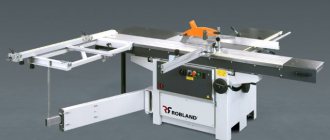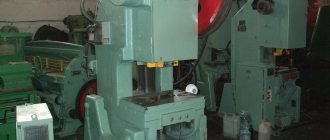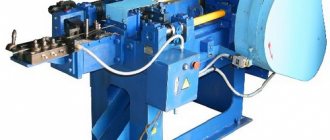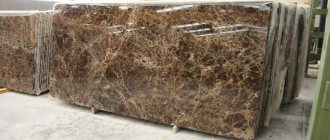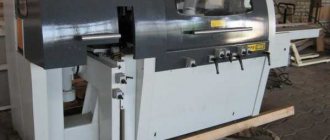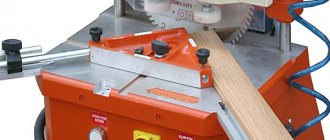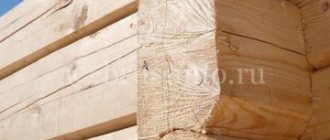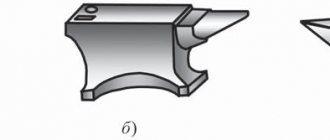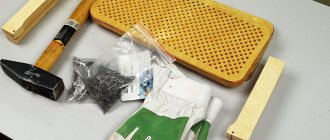Device
The main task of such equipment is to cut sheet materials to the required sizes. For this purpose, circular toothed discs are used. A typical saw blade allows mutual movement of the workpiece being cut and the saw blade. To do this, one of the parts - either a table with a disk holder and a motor, or a cutting table - is made movable. By promptly removing the already sawn material and moving the workpiece, it is completely dissolved into pieces.
The basic part of any sawing machine is the frame - the body or frame of the equipment, the heaviest and most durable part, which is usually attached to the floor or simply stands on it and does not move due to its weight.
The heavier the bed, the cleaner the cut, as it effectively absorbs the vibrations that the rotation of the electric motor and saw blade inevitably creates.
The next important element is the saw unit. Thanks to it, the workpiece dissolves into fragments. It consists of an alternating current electric motor of a certain power and an associated disk.
Most machines have the ability to tilt the saw blade at an angle to the material being cut. Typically the disc is capable of tilting in the range from 0 to 45°, but some manufacturers make a tilt unit from -45 to +45°. This allows you to cut parts with an oblique edge, which can be useful for joining sections.
Often, in addition to the main disc, a scoring disc rotates in front of it. It rotates in the opposite direction and ensures a clean cut without chipping. The use of a scoring disc is especially important when cutting coated materials, such as chipboard. In this case, the scoring disc can be powered by a separate, less powerful electric motor or through a gearbox from the main motor.
Work tables are attached to the frame. They serve to place sheets of material to be cut, as well as to move them relative to the saw blade. The dimensions of the workpieces that can be worked with on a particular machine depend on the number of work tables and their size.
The movement of sheets for cutting is carried out using a carriage - a system of guides, thanks to which one of the work tables can move smoothly and accurately. The carriage mechanism is made of aluminum - this metal is light and at the same time durable.
A system of rulers, scales and stops is used to accurately set dimensions. The marking stops are secured with screw and friction clamps. After this, the workpiece is aligned exactly according to them and the cut is made.
One of the rulers of the cutting table can move in a circle - this is necessary in order to cut at a given angle. To mark the exact angle, the ruler rotation scale is marked in degrees.
Lifehacks
In order to avoid chipping when cutting chipboard or laminated board, you must first draw a cutting line on the material with a sharp tool. Damage to the decorative layer of the slabs can be minimized by applying paper tape to the surface of the material along the cutting line.
You can reduce the number of chips on the cut edge of material sawed on light machines by reducing the vibration of the equipment during operation. To do this, work tables are additionally attached to the floor using metal corners and dowels.
Format cutting equipment ensures high accuracy of material cutting, which is fundamentally important for furniture production. With their help, angular, transverse and longitudinal cuts are made of particle boards of various densities, as well as solid wood.
Kinds
Despite the general principles of operation, machines can be of different types:
- Horizontal with movable table . The most common type. The saw unit is located in a slot in the upper part of the bed; sheets of chipboard or fiberboard are placed on a work table, which rides on a carriage relative to the disk. The design has proven itself to be universal; it is used in enterprises of all types.
- Horizontal with movable disk . In this version of format-cutting machines, a disk rides on a carriage slide, and the workpiece is fixedly fixed on the work table. This type is less common due to the fact that it gives a less clean and accurate cut, but in some aspects it is even simpler than the first.
- Vertical . They were invented for cramped production facilities and workshops. Thanks to the fact that the plane extends upward, a lot of space is saved. Almost all vertical machines are made automatic: in them the saw unit is located on a carriage, thanks to which it moves up and down thanks to special traction motors. Adjacent to the control unit is a processor unit, where the operator enters the cutting program.
Classification by intended use
Format cutting machines do not have a household design; these are purely industrial products. However, furniture manufacturing varies and each has different equipment needs.
Traditionally, there are three types of machines:
- Lungs . In this case, they really weigh little compared to more complex devices. However, their main difference is their simplified design and minimum adjustments. Such machines may not have a standard chip and dust suction system, disk tilt, or other functional devices. However, with a rather poor configuration and a not very strong design, they have a significant advantage: low price. Such units are used in small workshops, as well as in companies where furniture is made to order, that is, the flow is small. As a result, the machine is used periodically as orders accumulate. The engine life is designed for no more than 5 hours a day.
- Average _ They are equipped with small furniture workshops. Designed for continuous work during one work shift, which in most countries is eight hours. This type of equipment already contains all the necessary features of a professional tool: a full set of rulers, meters and stops, the necessary adjustments, and fastenings for equipment.
- Heavy . Large machines for continuous production. They work most of the day and are switched off only for a shift change. The large safety margin built into them is designed for constant operation under load. Such machines can be found in large furniture factories, where the loading of equipment is scheduled several days in advance.
Which panel saw would you buy?
Light/MediumHeavy
Popular models
Popular household machines that are in demand among medium and small furniture manufacturers include Mj 45 kb-2 and JTS-315SP SM. The equipment is convenient to use and has small dimensions. For Mj 45 kb-2, vibration is reduced due to a powerful welded frame, and for JTS-315SP SM, vibration is reduced due to a cast iron frame and an additional table. The disadvantage of the JTS model is the inconvenience of working with large-area material.
Large furniture manufacturers purchase models like Altendjrf F 45. This is high-precision equipment that makes clean transverse, longitudinal and angular cuts of materials. Adjustment of the height and angle of inclination of the main saw is electromechanical. The control system of these machines allows for high-quality cutting.
Enterprises producing serial furniture use CNC batch cutting centers. A prominent representative is the center for batch and piece cutting Filato FL 3200 V, where 3200 is the length of the cut. On such machines, it is possible to cut large slabs with a saw unit due to the wide table and elongated carriage. The existing scoring disc guarantees the quality of the work performed.
An amateur who knows how to make simple wooden fixtures and simple household furniture can make a formatik with his own hands. To do this, you will need to install a massive table and sawing equipment in your home workshop.
Features of choice
If the buyer has already decided on the type and configuration of the equipment, then finally he should also pay attention to the following characteristics:
Engine power . Lightweight machines have a motor with a power of 1.5 - 2 kW. This is sufficient for sawing thin plywood and fibreboards. In the case of wood chips, the cutting speed will be low. For cutting a single layer of large format, machines with a power of up to 4 kilowatts are suitable. Industrial units operating from a three-phase power supply allow cutting material in batches and stacks, and their power reaches 6 - 8 kW.- Disk size . The frames and attachment points for the equipment are made in such a way that it is possible to fasten the disk in a certain range of sizes. A 200 mm disc is considered the minimum standard, and 550 mm can be installed in heavy and some medium-sized devices. The maximum thickness of the material being cut depends on this parameter.
- Speed . The cutting speed and equipment performance depend on this number. Some models have speed control. To work with wood and wood-based materials, a frequency of 2500 to 6000 rpm is usually used.
- Carriage mechanism . Can be made using ball bearings or roller rolling devices on aluminum guides. Ball carriages are less susceptible to contamination, but roller carriages are able to withstand greater weight of sheets laid on the cutting table and have a long service life.
A cutting-format machine is a necessary piece of equipment for manufacturers of cabinet furniture and has a high degree of versatility. When choosing and purchasing machines, pay close attention to warranty service and repairs, since any breakdown can lead to downtime.
Equipment Manufacturers
In order to maintain sales volume, enterprises manufacturing woodworking equipment strive to improve the technical characteristics of machines and at the same time reduce their cost. Since this is high-precision equipment, its production is carried out by large machine-tool companies known in the world market.
When choosing a manufacturer, you need to study the market for maintenance services. Are there centers that service such equipment, what tools they use, who supplies spare parts.
The flagship manufacturers of woodworking equipment from Europe include the German concern Altendorf. The equipment they manufacture is well equipped, which allows for an even cut of the material being processed without much effort. They operate from a 380 V network. They have three switching speeds. The machines quickly pay for their cost if they are well loaded.
The Italian company Griggio has a good lineup. The formatting machine of this company is known all over the world and is represented in three categories - business, standard, budget. It performs many different options for processing materials and has high-quality equipment.
In 2009, to meet the needs of Russian furniture companies of small and medium-sized businesses in woodworking equipment, it was created. Produces models of high-quality design and execution. They are focused on global manufacturers of such equipment, which is confirmed by the components installed on the machines by the company.
There are many equipment manufacturers in the Chinese market. It is better to purchase such equipment from a trusted supplier with a good sales history, who not only sells, but also provides service and has spare parts in stock.
Security measures
You can start working on the machine after studying the machine equipment, operating rules and safety precautions.
It is necessary to keep the workplace clean. While the machine is operating, you must not lean on the equipment, perform cleaning, or be between operating components. It is forbidden to work on faulty equipment, therefore, if a problem is detected, the machine must be turned off immediately. You cannot start work if there is no grounding, and you need to stand on a dielectric mat. Electrical equipment must be tested for insulation strength. While the machine is running, you must not:
- transfer items;
- tighten screws, bolts, nuts and other parts;
- replace machine parts and options;
- process workpieces that exceed the technical specifications of the installation;
When working, do not wear loose clothing to prevent it from getting caught in moving parts of the equipment; shoes must have non-slip soles. To reduce noise exposure, use industrial headphones, to prevent eye injury, use safety glasses, and to protect the respiratory tract, use a respirator. It is recommended to cover your hair with a hat.
Sawing rules
First you need to choose a cutting method.
Be sure to carry out the following preparation (cutting):
- To protect the laminated surface of the board from damage during operation, you need to prepare masking tape or tape;
- for marking workpieces - a ruler and a pencil;
- From the ends of the slab, mark future cutting points with a pencil;
- in order to prevent chips from appearing, you need to stick masking tape or adhesive tape to the cut area;
- after gluing the tape, connect the preliminary marking points with a pencil;
- prepare sandpaper to finalize the cut lines.
The following rule applies not to preparation, but to actions after cutting, but is general for any method: if irregularities are found on the edges, then they need to be processed with a file or rasp. The ends resulting from cutting are covered with veneer with a pattern similar to the pattern of the laminated coating.
What not to saw
Chipboard cannot be sawed using an angle grinder, which is also called a grinder. When working with this tool, there is a high risk of injury, especially when using large diameter discs. Injury can also occur when the tool guard is removed from the tool.
Characteristics by type
Enterprises that manufacture small wooden structures with a small load on the equipment purchase machines with horizontal orientation.
They are equipped with a ball carriage with an angular stop. For many, the saw machine is mounted on a bed with a tilt system of up to 45 degrees. Such machines have independent systems for adjusting the height of sawing devices. Vertical roller machines are more precise in operation. They have smaller dimensions, since the processed material is in a vertical position, which helps to save production space. The machines allow you to work with cutting sheets of large sizes. It is not the workpiece that is moved in them, but the saw unit, either manually or using an electromechanical drive.
CNC batch cutting centers are used in large series and mass production. They are easy to operate, and the use of numerical control is a guarantee of the quality and accuracy of the work performed. Depending on the size of the sheets, the saw carriage and pushers are fed automatically. A high speed of movement is achieved by the leveling unit with the constant presence of a pressure roller.
Sequence of work
First, a strong metal frame is prepared that can serve as the basis of the machine. For this purpose, it is best to use a channel. The blanks are selected so that the result is a unit 6.5 - 6.7 m long, 2.5 m wide, and a height of eighty to one hundred and ten centimeters.
The main guide of the cutting equipment and the floor guide are designed and mounted on the bed. For them, it is best to use pipes whose dimensions are 6 cm in diameter, 6.5 m in length, and wall thickness - 5 mm. The moving part of the desktop should be made movable along guides. During the work process, it will be used to feed sheet material. This section can be moved manually or an additional CNC motor can be installed. Cutting lines along the length should be provided from three meters. This parameter can be increased or reduced by simply changing the size of the guides.
A pair of saws are hung on the bed - for the main cut and trimming. They are mounted on a saw unit so that rotation occurs in the opposite direction from the movement of a pair of asynchronous motors. It is recommended to provide the ability to tilt the block by forty-five degrees, for which you should use a rotating device on the sawing block.
You should choose electric motors carefully, because they will be intended to rotate the saws. Their power must be at least 2.9 kW. The motor must rotate the main saw at a speed of at least 5,000 revolutions per minute, and the scoring saw must produce three thousand revolutions more.
When creating equipment, it is best to use saw blades with a diameter of twenty-five centimeters, which will make it possible to cut not only laminated chipboard and trim sheets, but also to use a machine for sip panels.
Components of the machine
The machine consists of several elements:
- table;
- driving mechanism;
- auxiliary equipment.
The fixed base of a format-cutting machine or bed, which is a cast-iron milled plate. To process larger workpieces, you can increase the working area by adding extension or expansion plates and moving the stop fence.
The formatted cutting sheet is placed, as a rule, on the main plane of the movable table. In order to eliminate mechanical distortions under the maximum permissible weight of the package, it is arranged rigidly on the carriage.
Chip removal
After the first launches, another unpleasant feature was revealed - when you start cutting the sheet from above, all the shavings fly in a beautiful fountain directly onto the operator’s head. Therefore, they quickly began to solve the issue of chip removal, while the operator had to wear a technical jacket with a hood and glasses.
By that time, it was time for us to purchase a chip extractor in order to extract dust from 2 CNC milling machines, a circular machine, a sanding area with a sander, and from the future format machine. Since there are a lot of devices, we took a Jet 2300 2.2 kW chip ejector with 2 bags for 35 tr (a similar one for 1 bag costs 25 tr).
Chip ejector, without which the worker’s head was constantly covered in sawdust from sawing
In principle, if I had only one format machine, I would attach a vacuum cleaner with a long hose to it. In this option, it makes more sense to choose a circular saw with a connection for the vacuum cleaner hose. It’s better to take a vacuum cleaner with a large bag and a built-in socket for hand tools (connect the formatter through it). Then, when you turn on the formatter, the vacuum cleaner will turn on automatically and also turn off after turning off the saw (I use a Karcher vacuum cleaner with fabric bags, but I would prefer a larger bag). But in my case, the choice in favor of a chip extractor was obvious - you can’t install a vacuum cleaner on every machine (the money will be the same, but it will be very noisy and there will be a large load on the network). I assembled air ducts under the ceiling from sewer pipes, taped them inside with aluminum tape to remove static, and routed them to all the machines.
This is not a sewer under the ceiling))), but air ducts for removing chips to the chip suction
In order not to have to run to the chip ejector every time to turn it on, the power button was taken out and hung from the ceiling in the middle of the room.
To connect it to the formatter, I made a small casing from the same plywood and a small casing from the air duct (bought at a hardware store), which fits over the circular. It fits tightly, so no fastenings were required. You can easily remove it at any time to change the disc. I admit, it looks collective farm, but I had no time for beauty - I needed to resolve the issue as quickly as possible, and there was no time for beauty. As usual, everything temporary becomes permanent. Maybe I'll change it somehow.
The nozzle was made by the collective farm in a hurry, but it was necessary to quickly resolve this issue
The nozzle fits elastically, so there was no need to come up with any fastenings
By the way, regarding changing the disk, my circular saw has a submersible design, that is, the disk can be pulled out completely without removing the circular saw from the machine. This again simplifies operation.
How to make a formatbook with your own hands
Assembling a table with a movable carriage will be expensive and time consuming. The picture shows a diagram of a formatting machine.
The easiest way is to install a stationary saw unit on a massive table. Stages of assembling the sawing device:
- A massive table covered with smooth sheet material is installed.
- A circular saw is placed underneath on a hinged suspension. It is necessary that the working part of the cutter can move upward through the slot in the tabletop.
- Duralumin profiles are used as guide strips. A series of holes are made in the tabletop for installing workpiece clamps.
Historical excursion
The prototype of the current format-cutting machine was first demonstrated at the Paris World Exhibition in 1803. Among the craftsmen involved in the creation and improvement of such a tool, great success was achieved by the German carpenter Wilhelm Altendorf (1874-1948), who invented and manufactured the first FRS with a moving carriage in 1906. He also founded a small family business, Altendorf, which over time grew into a modern company that celebrated its centenary in 2006. Wilhelm Altendorf's sons - Kurt and Willy Altendorf - in 1956 reoriented their father's enterprise to produce exclusively format-cutting machines and subsequently significantly improved their design. Thanks to this, Altendorf GmbH & Co. KG Maschinenbau has become the world's leading manufacturer of this type of woodworking machines.
Manual cutting of chipboard parts: Step-by-step instructions
1 Draw out the dimensions of the slab on a piece of paper, preferably to scale. Don't forget to reduce it by 10mm on each side.
2 Sort the list by similarity of required parts. For example, the sides of kitchen cabinets have the same dimensions - 500 x 712 mm.
There are quite a lot of them, write down all such details separately. Continue sorting using the same principle: same width, same structure, and so on.
3 Lay out on a sheet of chipboard first the large parts and those that should have a similar structure. Don't forget about the width of the saw - 4 mm! This is where a calculator will definitely come in handy.
4 Place the remaining parts. You can work through several options until you get the one that is ideal, most economical and profitable.
